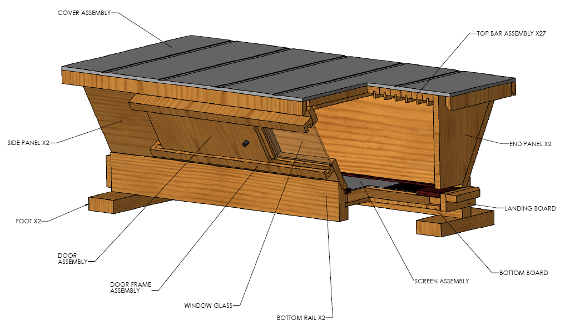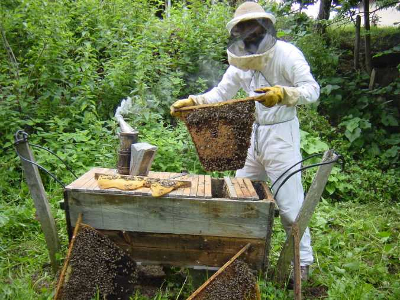
Top bar hive

PJ
Chandler's solution
to the ills
of modern beekeeping
is the top bar hive. The hive is simply a long box with sides
that slant inwards and a lid that fits over top. Removable frames
are placed in the box a bit like the frames in a Langstroth hive, but
top bar frames are just what they sound like --- simply a top
bar. The bees create their own wax just like they do in foundationless frames, which allows them to build
at a more natural cell size.
 One of the major selling
points of the top bar hive is that you can manage the hive in a very
unobtrusive fashion. The frames entirely enclose the space at the
top of the bees' nest area, so taking off the lid doesn't lower the
temperature inside much, nor does it bother the bees. The bee
colony is enclosed on the sides by two follower boards to keep them
from sprawling into the entire hive before they're ready, and
inspections can be as simple as sliding one follower board away from
the bees and peeking inside.
One of the major selling
points of the top bar hive is that you can manage the hive in a very
unobtrusive fashion. The frames entirely enclose the space at the
top of the bees' nest area, so taking off the lid doesn't lower the
temperature inside much, nor does it bother the bees. The bee
colony is enclosed on the sides by two follower boards to keep them
from sprawling into the entire hive before they're ready, and
inspections can be as simple as sliding one follower board away from
the bees and peeking inside.
Honey is usually
harvested one frame at a time, by cutting the entire comb off the
wooden frame. Although bees then have to redraw the wax on that
frame, cutting off the comb probably helps sanitize the hive, slowing
the buildup of diseases and pests. In general, you should
probably expect a bit less honey from a top bar hive than from a
Langstroth hive, but if that means your bees are healthier, I'd say the
trade is worth it.
Stay tuned for
tomorrow's post in which I'll discuss more of the pros and cons of top
bar hives, or check out our friend Everett's description of his top bar hive.
| This post is part of our The Barefoot Beekeeper lunchtime series.
Read all of the entries: |
Want more in-depth information? Browse through our books.
Or explore more posts by date or by subject.
About us: Anna Hess and Mark Hamilton spent over a decade living self-sufficiently in the mountains of Virginia before moving north to start over from scratch in the foothills of Ohio. They've experimented with permaculture, no-till gardening, trailersteading, home-based microbusinesses and much more, writing about their adventures in both blogs and books.
Want to be notified when new comments are posted on this page? Click on the RSS button after you add a comment to subscribe to the comment feed, or simply check the box beside "email replies to me" while writing your comment.

While you will get less honey with at top bar hive, how much honey do you really need? Homesteaders can probably supply their own needs with one hive. If they really like honey, maybe two or three spaced around their property. People who want to make a business out of it can just ask local landowners to put a few hives under a tree in an out of the way spot. And, you will get a ton of beeswax with top bar hive.